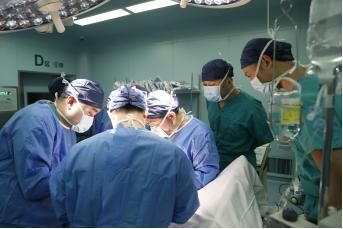
February 22, 2022, the 22nd day of the first month, Tuesday, the most loving and special day, Naval Medical University No. 3 Affiliated Hospital (Shanghai Oriental Hepatobiliary Surgery Hospital) Anting Campus has made joint efforts and close cooperation of multiple disciplines, and successfully completed a very difficult sacral recurrence tumor resection and reconstruction surgery.
Aunt Liu, 66 years old this year, unfortunately recurred after sacral tumor (chordoma) resection. She went to many local hospitals to no avail. After many inquiries, she came to Shanghai and found Shanghai Oriental Hepatobiliary Surgery Hospital Anting Hospital District Orthopedic Director Professor Wang Zhiwei.
“My mother had an operation more than 10 years ago, probably in 2011, and this time it relapsed.” Liu A?’s daughter told reporters, “We had an examination in the big hospital in my hometown. , after the recurrence this time, the situation is more serious than the last time. The doctor suggested us to operate, but the risk was too high, and the doctor was not sure, so we came to Shanghai to seek medical treatment.”
Sacral tumor surgery has a lot of bleeding and location Deep and difficult operation, the surgical treatment of recurrent sacral tumors is even more difficult. “The treatment of this patient involved consultations from multiple disciplines, because her condition was complicated, the chordoma recurred, and she was accompanied by severe hypertension. , Osteoporosis, in addition, she has mild anemia, there is a certain risk of surgery.” Wang Zhiwei said.
The difficulty of this operation is self-evident. On February 22, the operation lasted nearly 10 hours.
The director of the Department of Anesthesiology, Sun Yuming, introduced that the operation was successfully completed with the cooperation of experts and professors of orthopedics, urology, vascular surgery, plastic surgery, and anesthesiology. When Aunt Liu was sent out of the operating room, the time had already pointed to the early morning of February 23, and she would spend the relatively dangerous 24 hours after surgery in the intensive care unit.
It is reported that sacral tumors are rare tumors, and primary tumors are even rarer. Chordoma is the most common pathological type of sacral primary tumor, followed by giant cell tumor of bone and neurogenic tumor of sacrum.
The treatment of sacral tumors is mainly surgery. Due to the complex anatomical structure of the sacrum and its proximity to major blood vessels and important organs, the intraoperative bleeding is turbulent and the surgical risk is high. Since it is difficult to achieve wide margins of resection in the sacrum, the local recurrence rate after sacral tumor surgery is also high. The surgical treatment of sacral tumors has always been one of the difficult problems in the field of surgical treatment of bone and soft tissue tumors.
Intraoperative bleeding is an unavoidable problem in the surgical treatment of sacral tumors.
Because of the complex anatomical structure of the sacrum, the amount of intraoperative blood loss is often excessive, which will lead to unclear surgical field, difficult complete tumor resection, and hemorrhagic shock due to massive blood loss, which will eventually lead to the perioperative period. Mortality, intraoperative and postoperative complication rates, and local tumor recurrence rate increased, which significantly affected the safety and efficacy of surgery.
With the gradual maturity of interventional radiology methods, preoperative selective arterial embolization has also been widely used to reduce intraoperative hemorrhage of sacral tumors. Preoperative selective arterial embolization can effectively reduce the amount of intraoperative blood loss, and can cause necrosis inside the tumor, slightly reduce the mass, and facilitate complete tumor resection.
Experts remind that if you feel pain in the sacrococcygeal region or neurological symptoms in the lower extremities, or bowel and bladder dysfunction, you should not only consider the disease of lumbar disc herniation, but the most important thing is to visit an orthopedic specialist in time. rule out the disease.
Author: Li Chenyan, Cao Xi, Zhu Yaqing
Edit: Li Chenyan
Editor in charge: Tang Wenjia
Photo source: Courtesy photo
< p>*Wenhui’s exclusive manuscript, please indicate the source when reprinting.